Payette County Buildings Listed On
The National Register of Historic Places
Welcome to the Payette County IDGenWeb Project
The National Register of Historic Places (NRHP) was created in 1966 to recognize and document buildings, structures, or places of historic or architectural importance. For more on the National Register of Historic Places in Idaho or for information about having a home or building placed on the register contact:
The Idaho State Historic Preservation Office
To View the List of Payette County Buildings on the National Register visit their site at:
National Register of Historic Places Payette County
Historic Buildings in Fruitland Listed on the Register
Currently there are not any buildings in Fruitland listed on the register
Historic Buildings in New Plymouth Listed on the Register
 |
New Plymouth Congregational Church Southwest Avenue between West Park and Plymouth Tourtellotte and Hummel, Architects National Register Number 82000359 Joined the Register November 17, 1982 From National Register Application: The New Plymouth Congregational Church is a one-and-a-half-story structure - one tall story on an elevated basement - in a formal neo-classical revival style. The massive, stuccoed concrete structure is rectangular. A monumental outset portico has a low-pitched, pedimentally-treated gable outset on two-story Tuscan columns. Cross gables are centered on the side elevations. |
 |
Historic Buildings in Payette Listed on the Register
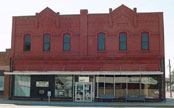 |
A. B. Moss Building 137 North 8th Street in Payette National Register Number 78001093 Joined the Register February 08, 1978 From National Register Application: The A. B. Moss building is a two-story brick commercial building which is distinguished by the two large brick "chevrons" which break the roof line and function as false fronts for twin facade units. The "chevrons" emerge from a unique banded brick ornamentation and are flanked by abbreviated piers which terminate with brick finials. The windows, which have cut stone sills and brick segmental arches with stone keystones, are united by a brick banding. The facade's first-story, with its recessed center doorway and border of black tiles with orange lozenges, was the result of a 1926 remodeling. Except for this, and a coat of green paint above, this building remains unaltered. |
 |
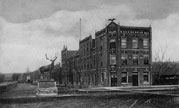 |
Coughanour Apartment Block 700-718 1st Avenue North in Payette National Register Number 78001092 Joined the Register May 23, 1978 Sadly, The Coughanour Apartment Block was Demolished in 1985. From National Register Application: The Coughanour Apartment Block is a three-story building in brick commercial style. The major decorative motifs are in brick, although the building has pressed tin applied ornamentation as well as good leaded glass transoms. |
 |
 |
David C. Chase House 307 9th Street North in Payette Campbell and Hodgson Architects National Register Number 78001091 Joined the Register February 07, 1978 From National Register Application: Campbell and Hodgson of Boise, Architects. The David C. Chase residence is a two story brick Queen Anne house which is distinguished by its tower and windows with detailed wood paneled frames. The rectangular tower rises from a corner porch, and has a flared hipped roof with a finial. The house's gables are similarly flared. A bay window is to the left of the porch and to the right is a round arched window with Romanesque character. The tower has a narrow round arched window and a pair of windows with colored glass surrounding them. Several of these windows have cut stone sills. |
 |
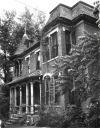 |
Grant Whitney House 1015 7th Avenue North in Payette Walter Campbell, Architect National Register Number 78001095 Joined the Register February 23, 1978 The Grant Whitney House was Destroyed by Fire in 1985 From National Register Application: The Grant Whitney residence, with its Mansard roof, dormers, and unbalanced mass is an unusual example of the combination of Mansard and Queen Anne forms rendered in brick. The rectangular east two story bay enhances the structure's commanding verticality, while the round west tower with its second story balcony adds to the picturesqueness. The porch is heavily bracketed and has hexagonal columns. Its original balustrade and cast iron roof cresting are missing. |
 |
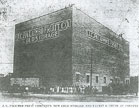 |
J.C. Palumbo Fruit Company Packing Warehouse Building 2nd Avenue and 6th Street in Payette Tourtellotte and Hummel Architecture National Register Number 82000360 Joined the Register November 17, 1982 The building was completed in the fall of 1928 at a cost of over $100,000 From National Register Application: The J. C. Palumbo Fruit Company Packing and Warehouse Building is a 12 by74 foot industrial structure presenting a nearly unfenestrated four-story profile on a site directly across from the railroad tracks in west Payette. Walls are red brick with deep concrete linels over all openings, which are almost entirely confined to the first floor and the shallow basement. |
 |
 |
Methodist Episcopal Church of Payette Now the Payette County Historical Society Museum 1st Avenue South and 9th Street in Payette William Noot, Designer National Register Number 77000469 Joined the Register October 05, 1977 From National Register Application: The Payette, Idaho, Methodist Episcopal Church is a brick building with wooden frame roof and Queen Anne gable detailing. The basic style is Gothic, but this is indicated almost exclusively by lancet windows and not by buttresses, finials, or other Gothic features. |
 |
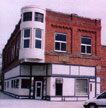 |
N. A. Jacobsen Building North 8th Street and First Avenue in Payette Tourtellotte and Hummel, Architects National Register Number 82000358 Joined the Register November 17, 1982 From National Register Application: The N. A. Jacobsen Building in Payette is a two-story brick structure with a thirty-foot frontage on North Eighth Street, the main street of the town, and a seventy-nine-foot frontage on First Avenue. The building was designed to enclose one large store space on the first story and offices on the second. |
 |
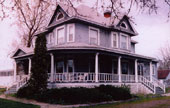 |
N. A. Jacobsen House 1115 First Avenue North in Payette Hutchinson Brothers, Builders National Register Number 97001610 Joined the Register January 07, 1998 From National Register Application: The N.A. Jacobsen House is a frame dwelling standing two stories in height, located on a large lot at the northeast corner of First Avenue North and Ninth Street in Payette, Payette County, Idaho. Large deciduous and evergreen trees shade the yard, and a semi-circular drive provides access to the house from First Avenue to the south. A two-car brick garage, originally used as a blacksmith shop, is set on the northeast corner of the lot. The house is in excellent condition and shows little exterior alteration since its construction. |
 |
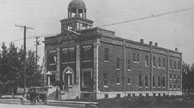 |
Payette City Hall and Courthouse 3rd Avenue and 8th Street in Payette J. Ronald Walker, Builder National Register Number 79000808 Joined the Register May 14, 1979 From National Register Application: The Payette City Hall is a two-story brick building in the Neo-Classical Revival style, which sits on a raised foundation. It is distinguished by a slightly outset entry bay which rises to a pedimented cornice. The building is three bays wide and four bays deep. Terra cotta pilasters delineate the bays. Double hung sash windows with terra cotta flat arches are found in each bay. The first story windows are framed with quoins. The facade and central bay contain a round arched entry with a fan light it is tympanum. A flight of steps which extend from the sidewalk provide access to the double doorway. A similar entry is located at ground level on the building's northside. |
 |
 |
Payette's Old Main United States Post Office 915 Center Avenue in Payette National Register Number 89000134 Joined the Register March 16, 1989 From National Register Application: The Payette Main Post Office is a single-story red brick building on a raised concrete basement. The building consists of the original construction and an addition to the west side (1964). The facade of the original building is flat, symmetrical, divided into five bays, and devoid of significant detailing. A centered entry bay with two window bays (all flat-arched) on either side break the otherwise plain facade. Granite steps and landing, flanked by square concrete buttresses capped with limestone, provide access to the double-door entry. The window bays immediately flanking the entry are of the same size as the entry bay. Plain concrete panels are inset beneath the sill and bas relief decorative limestone panels are inset above the sash. These two panels and one above the entry transom depict the three modes of transportation: locomotive, ship, and airplane. Narrower than the interior windows, the end windows are framed by flat cast concrete lintels and sills with a plain concrete panel beneath. A narrow belt course marking the tops of the three central bays extends along the entire front facade (including addition). The addition (west side), which is slightly recessed, is identical in use of materials and detailing to the original building. Two windows bays configured identically to the original end windows divide the plain brick wall of the addition. The entire facade is completed by a plain brick parapet, topped with cast-concrete coping. Behind the parapet is a flat roof of built-up tar composition. |
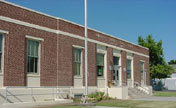 |
 |
Portia Club 225 N 9th Street in Payette Ike Whiteley, Architect National Register Number 10000159 Joined the Register April 7, 2010 From National Register Application: The Portia Club is located in Payette, a community of approximately 8,000 (2010) in southwestern Idaho. The clubhouse sits at 225 N. 9th Street. The single story building measures 32' x 56'. with a rear kitchen addition measuring 18' x 24.' Designed in the Spanish Colonial Revival Style, the Portia Club is unlike neighboring buildings, not only in style, but also in function and age. The building to the south is a brick church, possibly built around the same time, while the remaining structures are residential and appear to be built in or after the 1950s. There are no other structures of this style in the vicinity, which allows the Portia Club site to stand out in its setting. |
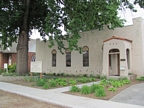 |
 |
St. James Episcopal Church 1st Avenue North and 10th Street in Payette Ben McIntire and H.M. Williams, Builders National Register Number 78001094 Joined the Register April 20, 1978 From National Register Application: St. James Episcopal Church is a good example of an English country church of the Gothic style rendered in brick. Its gabled roof has triangular stained glass dormers and a white shingled belfry at the front. The belfry rises from two buttress-like piers which frame a large stained glass Gothic window which contains a rose window. Brick buttresses accent corners and demarcate the four side bays, each of which contains a stained glass lancet window. |
 |
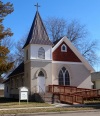 |
St. Johns Church 2350 N 4th Street in Payette National Register Number 13000353 Joined the Register June 5, 2013 From National Register Application: St. John's Church is located at 350 North 4th Street (facing south on the southeast corner), of the town of Payette, Payette County, Idaho. It is built on lots 7 and 8, in block 5 of the Platt addition. Built in 1911 , the building has been in continuous use by a single congregation. The building is a single-story modest Gothic revival, rectangular in shape, measuring 50 feet by 30 feet. An addition added to the rear of the church in 1966 measures 26 feet by 28 feet. The current measurement of the building is 7 4 feet by 30 feet. A basement room was excavated in 1965 and it measures 44 feet by 24 feet. The original building sits on a 3 foot rusticated concrete block foundation and its walls are a running bond brick pattern sitting on a header row. A 1918 Parsonage house sits immediately to the south of the church. The modest bungalow has an associated garage to the west. |
 |
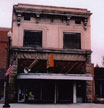 |
Woodward Building 23 8th Street in Payette National Register Number 78001096 Joined the Register April 26, 1978 From National Register Application: The Woodward Building 1s a two story, 30' x 90', brick commercial building which is distinguished by its classically inspired Iron cornices and white pressed brick facade. The applied ornamentation Includes a cavetto between the first and second stories which is supported by modillions at each end and a cornice with four modillions. Rusticated sandstone frames the plate glass windowed first story and the second story windows are framed by brick layed to give a corbelled affect. |
 |
Learn More About Historic Building Preservation, Grants, and Assistance
| Idaho Heritage Trust | The Idaho Historic Preservation Council | The Idaho State Historic Preservation Office | National Trust for Historic Preservation |
Return to Payette County IDGenWeb Home
